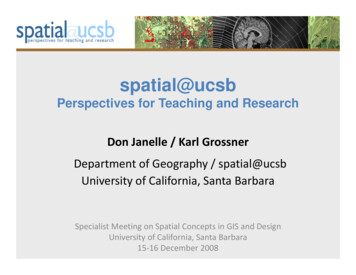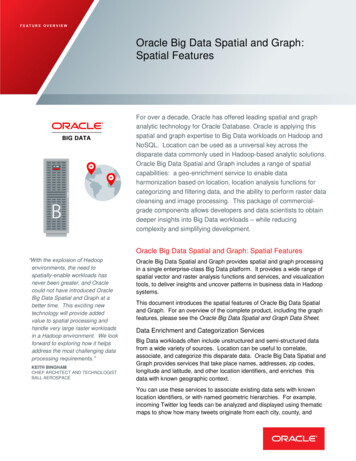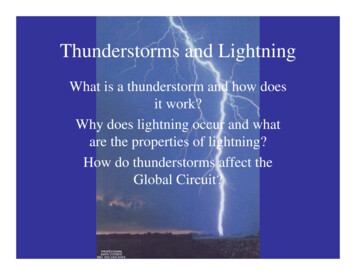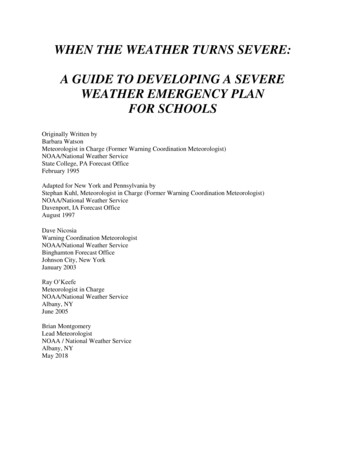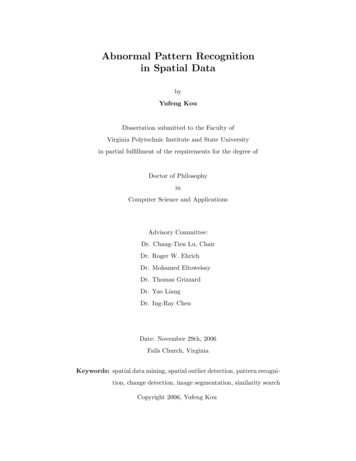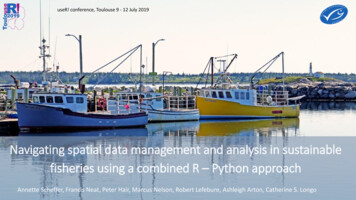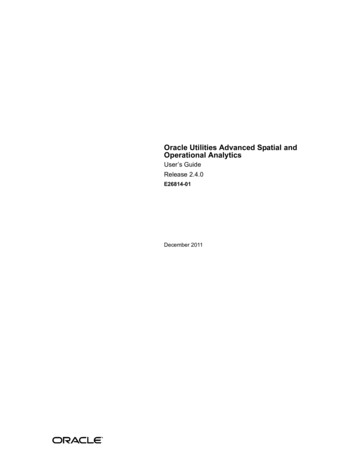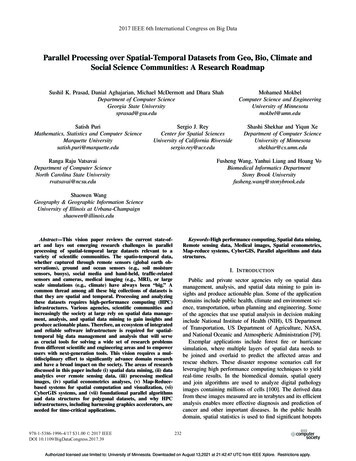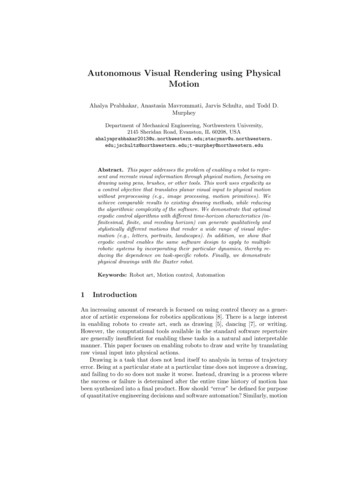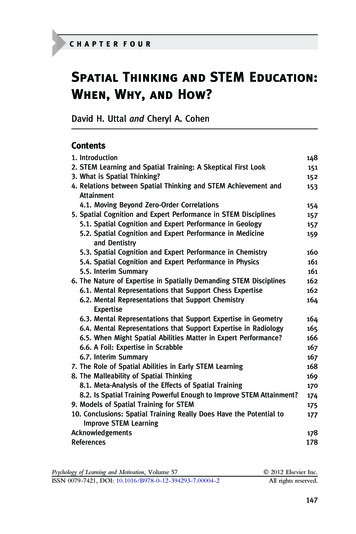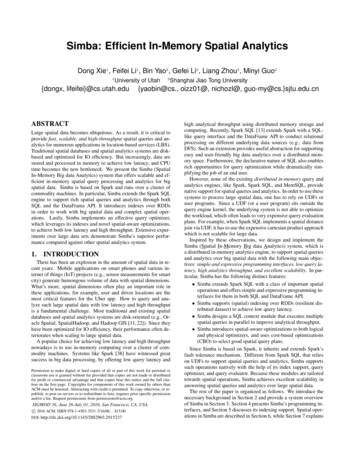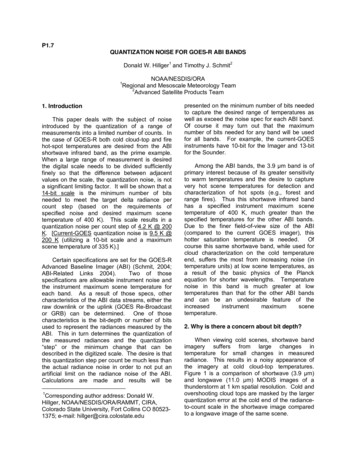
Transcription
P1.7QUANTIZATION NOISE FOR GOES-R ABI BANDSDonald W. Hillger1 and Timothy J. Schmit2NOAA/NESDIS/ORARegional and Mesoscale Meteorology Team2Advanced Satellite Products Team11. IntroductionThis paper deals with the subject of noiseintroduced by the quantization of a range ofmeasurements into a limited number of counts. Inthe case of GOES-R both cold cloud-top and firehot-spot temperatures are desired from the ABIshortwave infrared band, as the prime example.When a large range of measurement is desiredthe digital scale needs to be divided sufficientlyfinely so that the difference between adjacentvalues on the scale, the quantization noise, is nota significant limiting factor. It will be shown that a14-bit scale is the minimum number of bitsneeded to meet the target delta radiance percount step (based on the requirements ofspecified noise and desired maximum scenetemperature of 400 K). This scale results in aquantization noise per count step of 4.2 K @ 200K. [Current-GOES quantization noise is 9.5 K @200 K (utilizing a 10-bit scale and a maximumscene temperature of 335 K).]Certain specifications are set for the GOES-RAdvanced Baseline Imager (ABI) (Schmit, 2004;ABI-Related Links 2004).Two of thosespecifications are allowable instrument noise andthe instrument maximum scene temperature foreach band. As a result of those specs, othercharacteristics of the ABI data streams, either theraw downlink or the uplink (GOES Re-Broadcastor GRB) can be determined. One of thosecharacteristics is the bit-depth or number of bitsused to represent the radiances measured by theABI. This in turn determines the quantization ofthe measured radiances and the quantization“step” or the minimum change that can bedescribed in the digitized scale. The desire is thatthis quantization step per count be much less thanthe actual radiance noise in order to not put anartificial limit on the radiance noise of the ABI.Calculations are made and results will be1Corresponding author address: Donald W.Hillger, NOAA/NESDIS/ORA/RAMMT, CIRA,Colorado State University, Fort Collins CO 805231375; e-mail: hillger@cira.colostate.edupresented on the minimum number of bits neededto capture the desired range of temperatures aswell as exceed the noise spec for each ABI band.Of course it may turn out that the maximumnumber of bits needed for any band will be usedfor all bands. For example, the current-GOESinstruments have 10-bit for the Imager and 13-bitfor the Sounder.Among the ABI bands, the 3.9 µm band is ofprimary interest because of its greater sensitivityto warm temperatures and the desire to capturevery hot scene temperatures for detection andcharacterization of hot spots (e.g., forest andrange fires). Thus this shortwave infrared bandhas a specified instrument maximum scenetemperature of 400 K, much greater than thespecified temperatures for the other ABI bands.Due to the finer field-of-view size of the ABI(compared to the current GOES imager), thishotter saturation temperature is needed.Ofcourse this same shortwave band, while used forcloud characterization on the cold temperatureend, suffers the most from increasing noise (intemperature units) at low scene temperatures, asa result of the basic physics of the Planckequation for shorter wavelengths. Temperaturenoise in this band is much greater at lowtemperatures than that for the other ABI bandsand can be an undesirable feature of theincreasedinstrumentmaximumscenetemperature.2. Why is there a concern about bit depth?When viewing cold scenes, shortwave bandimagery suffers from large changes intemperature for small changes in measuredradiance. This results in a noisy appearance ofthe imagery at cold cloud-top temperatures.Figure 1 is a comparison of shortwave (3.9 µm)and longwave (11.0 µm) MODIS images of athunderstorm at 1 km spatial resolution. Cold andovershooting cloud tops are masked by the largerquantization error at the cold end of the radianceto-count scale in the shortwave image comparedto a longwave image of the same scene.
Figure 1: Shortwave (3.9 µm) image on top, and longwave (11.0 µm) on bottom. Both are MODISimages of a thunderstorm at 1 km spatial resolution. Cold and overshooting cloud tops are masked bythe larger quantization error at the cold end of the radiance-to-count scale in the shortwave imagecompared to a longwave image of the same scene.3. Bit-Depth MethodologyWith the focus on the GOES-R ABI shortwaveband (3.9 µm), Figure 2 gives a graphicalrepresentation of the process of determining thebit-depth needed to meet the requirements of boththe maximum and minimum temperatures thatneed to be measured, as well as the desiredtarget delta radiance for measurements. Thedelta radiance needs to be precise enough to notallow quantization errors, or a difference that istoo large between adjacent values, that woulddominate a smooth scaling of the measurements.
The process involves expanding the range ofneeded temperatures by a fixed temperatureincrement of 10 K (on the hot end) and extendingthe temperature down to 0 K (on the cold end).This assumes that space-view measurementsnear 4 K are desired for calibration purposes. Thetemperature range is further expanded on eachend by a multiple of 5 times the desired NoiseEquivalent Delta Temperature (NEdN), to be surethat noise does not interfere with themeasurements on either end of the scale. Thescale is then divided by the target delta radiance,which is related to a fixed factor times the NEdN,that factor being 1 over 2.5 in this case, again tobe sure that the quantization into counts does notlimit the measurements in any way.Figure 2: Example of computing bit-depth needed for GOES-R ABI band-7 (3.9 µm)The process outlined graphically in Figure 2has been applied to GOES-R ABI infrared bands7-16, with results in Tables 1a, b, and c. Theresult is the required bit depth for each band, andthe delta radiance count per count step thatresults from that bit depth.
Table 1a: Relating ABI Specifications of Noise and Instrument Max Scene Temperature toMaximum Radiance[Radiance units: mW/ cNEdN1(mW/ )InstrumentMaximum imumSceneTemperature(K)for Scaling3410310310330340310340340340315Max SceneRadiance plus 5xnoise (mW/ )for 71.71From Radiometric Precision Table of ABI Performance and Operational Requirements Document(PORD), 2004.2From Dynamic Range Table of ABI Performance and Operational Requirements Document (PORD),2004.3Instrument Maximum Scene Temperature plus 10 K, based on GVAR IR Scale Factor Coefficientmemo, 1991.4Five times multiplication factor for the Spec Noise, based on GVAR IR Scale Factor Coefficient memo,1991.Table 1b: Relating ABI Specifications of Noise and Instrument Max Scene Temperature toMinimum Radiance[Radiance units: mW/ cNEdN(mW/ )1InstrumentMinimum SceneTemperature 344444444445MinimumSceneTemperature(K)for Scaling50000000000Min SceneRadiance minus 5xnoise (mW/ )for .85-2.65Radiance from space assumed to be zero for all bands, based on GVAR IR Scale Factor Coefficientmemo, 1991.
Table 1c: Relating ABI Specifications to Required Bit Depth[Radiance units: mW/ cNEdN(mW/ arget DeltaRadiance perCount Step:NEdN/2.56(mW/ 1RadianceRange(mW/ 4.0174.3MinimumNumber ofBitsRequired814111111121112121210ResultingDelta Radianceper CountStep9(mW/ 76Factor of 2.5 based on e-mail correspondence with Mike Weinreb, 2004.Radiance Range between Max and Min Scene Radiances with noise.8Radiance Range divided by Target Delta Radiance and rounded up to next whole bit.9Delta Radiance based on rounded whole bits.74. Quantization Noise for ABI Band-7Our study will now focus on the quantizationnoise as a function the scene temperature for ABIband-7 (3.9 µm). The bit-depth needed for anyABI band can then be translated into aquantization noise.The process takes intoaccount the fact that the temperature differencebetween counts increases significantly for colderscene temperatures, a result of the basic physicsof the Planck function. Figure 3 shows for theshortwave infrared band that the deltatemperature (on the y-axis) per fixed deltaradiance (on the x-axis) increases sharply as thescene temperature decreases.
Figure 3: The Planck function for the GOES shortwave infrared window band (3.9 µm) showing how thesame delta radiance translates into vastly different delta temperatures as a function of the scenetemperature, with much larger delta temperatures for cold cloud tops viewed by this band.The process shown graphically in Figure 3has been applied to the GOES-R ABI shortwaveinfrared band (3.9 µm) for both cold cloud tops(200 K) and warm scenes (300 K), with results inTable 2a and b respectively. In each table thequantization noise for each band is given as afunction of both the maximum desired scenetemperature and the number of bits allowed byvarious scales. The results in Table 2a are thecrucial ones, as the quantization noise on thewarm end (Table 2b) is insignificant except forsmall bit depths (10-bits) and very warm scenetemperatures (400 K).
Table 2a: Relating Instrument Maximum Scene Temperature and Number of Bits to QuantizationNoise for Cold Cloud Tops (using a linear radiance-to-count conversion)Quantization Noise(K) @ 200 KABI band-7(3.9 µm)Maximum SceneTemperature(K)Number of -bit(0-65,535)35028.44.91.20.30375 9.92.30.58400 21.24.21.0Notes:- Current-GOES quantization noise is 9.5 K @ 200 K (utilizing a 10-bit scale and a maximum scenetemperature of 335 K).- ABI noise spec (0.1 K @ 300 K and 1.4 K @ 240 K) is equivalent to a noise of 32.1 K @ 201 K.Table 2b: Relating Instrument Maximum Scene Temperature and Number of Bits to QuantizationNoise for Warm Scenes (using a linear radiance-to-count conversion)Quantization Noise(K) @ 300 KABI band-7(3.9 µm)Maximum SceneTemperature(K)Number of 50.0110.00284000.320.0810.0200.0051Notes:- Current-GOES quantization noise is 0.060 K @ 300 K (utilizing a 10-bit scale and a maximum scenetemperature of 335 K).- ABI noise spec (0.1 K @ 300 K)
Based on the requirements of a desiredmaximum scene temperature of 400 K, and a 14bit scale as the minimum number of bits neededto meet the target delta radiance per count step(from Table 1c), the resulting quantization noiseper count step in Table 2a is 4.2 K @ 200 K.[Current-GOES quantization noise is 9.5 K @ 200K (utilizing a 10-bit scale and a maximum scenetemperature of 335 K).]Figure 3 showsgraphically the results for this combination of 400K instrument maximum scene temperature (410 Kmaximum scene temperature for scaling) and 14-bits of depth. Vertical dashed lines are imposedtemperature limits. The horizontal dashed line isstandard 1-byte count-to-temperature Look-UpTable (LUT) currently used for display of GOESimagery (Hillger 1999). This LUT has 0.5 Kprecision above 242 K (-31 C) and 1 K precisionbelow that temperature.The temperatureprecision for this band increases rapidly for lowtemperatures and is greater than the desired LUTprecision for temperatures below about 220 K (53 C).Figure 3: Quantization noise (K) as a function of scene temperature for ABI band-7 (3.9 µm) for a 14-bitscale. Vertical dashed lines are imposed temperature limits. Horizontal dashed line is standard 1-bytecount-to-temperature Look-Up-Table (LUT) currently used for GOES data. Temperature precision is notwithin the desired LUT precision for temperatures below 220 K (-53 C).
5. ConclusionReferencesAlthough a14-bit scale is probably sufficientfor the ABI shortwave infrared band, a 16-bit scalewould further ensure that quantization noise wouldnot be a limiting factor for this band. As analternative, in order to avoid large quantizationnoise for low temperatures, a non-linear scalecould be devised that would tend to equalize theerror (in temperature units) as a function of scenetemperature. Such a scale, utilizing the samenumber of bits, would add precision at lowtemperatures, at the expense of the precision athigher ec.wisc.edu/goes/abi/links.html,CIMSS/SSEC, University of WisconsinMadison.Geostationary Operational Environmental Satellite(GOES), GOES-R Series, Advanced tsDocument(PORD),Implementation Review, 2004: DOORsImplementationVersion2.0,417-RABIPORD-0017, (January 23), 36-p.AcknowledgementsFunding for this study is made availablethrough NOAA Grant NA67RJ0152. The views,opinions, and findings contained in this article arethose of the author(s) and should not beconstrued as an official National Oceanic andAtmospheric Administration or U.S. Governmentposition, policy, or decision.Hillger, D.W., 1999: GOES Imager and Soundercalibration, scaling, and image quality. NOAATech. Rep., NESDIS 93, June, 34-p.Schmit, T.J., J. Li, M.M. Gunshor, C.C. Schmidt,W.P. Menzel, J. Gurka, and J. Sieglaff, 2004:Study of the Advanced Baseline Imager (ABI)on the GOES-R and beyond, 84th AMSAnnual Meeting, Seattle WA.
12 9.61 0.16 300 310 109.2 13 10.35 0.17 330 340 184.4 14 11.2 0.17 330 340 200.0 15 12.3 0.17 330 340 213.2 16 13.3 0.53 305 315 171.7 1 From Radiometric Precision Table of ABI Performance and Operational Requirements Document (PORD), 2004. 2 From Dynamic Range Table of ABI Performance and Operational Requirements Document (PORD),
